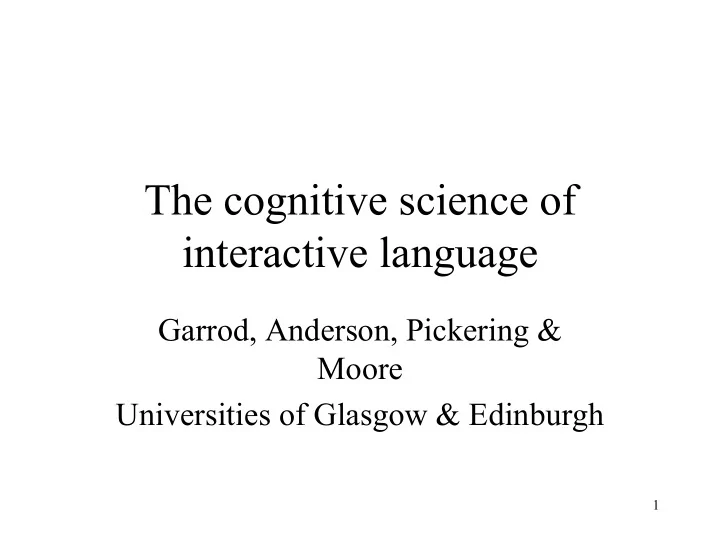

The cognitive science of interactive language Garrod, Anderson, Pickering & Moore Universities of Glasgow & Edinburgh 1
Individuals vs. systems • Vast majority of research into human cognition (and cognitive neuroscience) is concerned with the individual • But a systems-level approach is very important and practically relevant – Human-human interaction – Human-computer interaction 2
Interactive language • Natural language dialogue is fundamental to interaction – Involves linguistic but also non-linguistic aspects (gestures, pictures, etc.) • Understanding dialogue involves – Cognitive neuroscience, psychology, linguistics – Computer scientists, electrical engineers, etc. 3
Views of interaction • Traditional view – Interaction just “adds noise” • Our view – Natural cognitive systems did not evolve in isolation – They evolved by developing mechanisms for interaction • Challenge – To understand natural interactive mechanisms – Through behavioural and neuroscientific experimentation, modelling, etc. 4
Information alignment rather than information transfer 5
Alignment • In successful conversations, interlocutors eventually share relevant knowledge – Their “mental models” converge • Alignment may occur via extensive reasoning about each others’ minds – working out what they know and what they don’t • Or it may occur via fairly automatic “priming” mechanisms – Interlocutors tend to repeat each others’ word choices, grammatical choices, etc. 6
Studying interactive alignment Box of selected cards “The chef giving the jug to the swimmer.” CONFEDERATE SUBJECT Confederate script Box of cards to be 7 described
The study of dialogue • Dialogue clearly more basic than monologue • But current mechanistic accounts of language use are concerned with monologue – Comprehension and production of isolated words and sentences, reading texts … • For example, EEG/fMRI studies of word recognition in isolation – Contrasts with a social cognitive neuroscience of language • Generalizes far beyond language – e.g., interactive problem solving 8
Computational applications • Importance of dialogue systems – Direction-giving systems, travel/entertainment booking systems – But hampered by non-interactive approaches to cognition – Such systems will benefit enormously from cognitive/neuroscientific approaches to language over the next 2 decades or so – Relevance of planning in sensory-motor domains • Integration of linguistic and non-linguistic planning • Relevance of animal as well as human work 9
10
Eye-tracking technology • An example of a sophisticated methodology that can be employed during natural interaction • Allows moment-by-moment investigation of the processes in interactive language use – Recent work investigates where people look while speaking and listening – But almost no work investigating dialogue • e.g., synchronization between interlocutors 11
Towards a research programme • Controlled scientific investigation of natural interaction using hybrid methods – Analysing speech, eye movements – Integration of cognitive neuroscientific methods – Computational modelling • Replace study of isolated utterances with a study of situated interaction, drawing upon the multimodal context – Facial and manual gestures – Physical surroundings 12
Research questions & approaches • Dialogue and alignment of attention – Dialogue-based ‘visual world paradigm’ experiments • Computational modeling of the alignment process • Defining the dialogue-monologue continuum • Role of feedback, reciprocity, social factors in interactive alignment – e.g., investigate effects of group size on discussions using sophisticated multi-speaker monitoring equipment 13
Recommend
More recommend